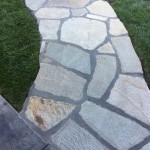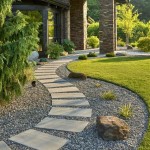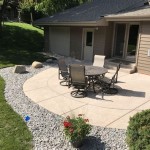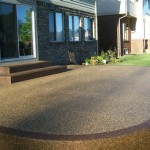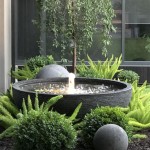Creative Patio Shape Ideas For Your Home Made Perfect
A patio provides an invaluable extension of a home’s living space, offering an area for relaxation, entertainment, and connection with the outdoors. Beyond its practical function, the shape of a patio significantly contributes to its aesthetic appeal and overall usability. Selecting the right patio shape requires careful consideration of the existing landscape, architectural style of the house, and intended purpose of the outdoor space. This article explores several creative patio shape ideas that can transform a home into a perfect living environment.
Rectangular Patios: Classic and Versatile
The rectangular patio is arguably the most common and straightforward design. Its popularity stems from its inherent simplicity and adaptability. A rectangular shape seamlessly integrates with most architectural styles, particularly those with clean, straight lines. It maximizes usable space, making it ideal for larger gatherings and accommodating various outdoor furniture arrangements. The straight lines also facilitate easy incorporation of features such as outdoor kitchens, fire pits, and dining areas. The regularity of the shape simplifies construction, potentially reducing labor costs. Furthermore, rectangular patios complement both modern and traditional landscapes.
Consider the dimensions when planning a rectangular patio. A long, narrow rectangle might be suitable for a side yard, while a broader rectangle is better suited for a backyard adjacent to the main living area. The size should be commensurate with the intended use. A small rectangular patio might accommodate a bistro set, while a larger one can comfortably host outdoor dining and lounging areas. The orientation of the rectangle is also crucial; aligning it with the house's existing lines creates a cohesive and harmonious design.
Material choices for a rectangular patio are extensive. Concrete pavers, brick, natural stone, and composite decking are all viable options. The chosen material should complement the home's exterior and surrounding landscape. For example, brick may enhance a traditional-style home, while concrete pavers could create a sleek, modern look. The installation process is generally straightforward, especially with prefabricated pavers or decking materials. However, proper site preparation, including leveling and drainage, is crucial for ensuring the patio's longevity.
To enhance a rectangular patio's visual appeal, consider incorporating borders or edging. A contrasting material, such as cobblestone or decorative bricks, can define the patio's perimeter and add visual interest. Plants, either in the ground or in containers, can soften the hard edges and create a more inviting atmosphere. Lighting, both functional and decorative, is another essential element. String lights, pathway lighting, and spotlights can illuminate the patio and extend its usability into the evening hours.
Curved Patios: Softness and Organic Flow
In contrast to the sharp angles of rectangular patios, curved patios offer a softer, more organic aesthetic. These designs are characterized by flowing lines and rounded edges, creating a visually appealing and inviting space. Curved patios are particularly effective in softening the overall appearance of a home and integrating it more seamlessly with the surrounding landscape. They can be designed to follow the contours of the yard, creating a natural and harmonious extension of the indoor living area.
Designing a curved patio requires careful consideration of the existing landscape features. The curves should complement the natural topography and avoid creating awkward or unusable spaces. The size and shape of the patio should be proportionate to the house and yard. A small, gently curved patio may be sufficient for a small garden, while a larger, more elaborate design is better suited for a spacious backyard. The curvature can be subtle or dramatic, depending on the desired effect. A gentle curve creates a more relaxed and inviting atmosphere, while a sharper curve can add visual interest and define distinct areas within the patio.
Material selection for curved patios is diverse, although some materials are more suitable than others. Natural stone, such as flagstone or irregular pavers, lends itself well to curved designs due to its inherent irregularity. Composite decking can also be used to create curved patios, although it may require more careful planning and cutting to achieve a smooth, seamless curve. Concrete pavers can be used, but smaller pavers are generally easier to work with when creating curves. The choice of material should harmonize with the surrounding landscape and the architectural style of the house.
The construction of a curved patio may be more challenging than that of a rectangular patio. Creating accurate curves requires careful planning and measurement. A flexible form can be used to outline the desired shape before excavation. The sub-base should be properly compacted to ensure a stable foundation. Laying the pavers or decking materials along the curve requires precision and attention to detail. Grouting or sealing the joints is essential to prevent weed growth and water damage. Adding plants around the perimeter of the curved patio can further enhance its natural appeal. Consider using a variety of textures and colors to create visual interest. Benches, water features, and lighting can also be incorporated to enhance the patio's functionality and aesthetic appeal.
Circular Patios: Focal Point Design
A circular patio serves as an elegant and eye-catching focal point in any outdoor space. Its inherent symmetry and balanced proportions create a sense of harmony and tranquility. Circular patios work particularly well in gardens or backyards that lack defined features. They provide a central gathering space and can be incorporated into a variety of landscape designs.
The size of a circular patio should be carefully considered in relation to the surrounding landscape. A small circular patio may be suitable for a intimate seating area, while a larger one can accommodate a dining table or fire pit. The placement of the circle is equally important. Centering it in the yard creates a strong focal point, while offsetting it can create a more dynamic and asymmetrical design. The choice of materials can significantly impact the overall aesthetic. Natural stone, brick, and concrete pavers are all viable options. Consider using a contrasting border to define the circle's perimeter and enhance its visual impact.
Building a circular patio requires careful planning and execution. The first step is to determine the desired diameter and mark the circle's perimeter using a string and stake. Excavate the area within the circle to a depth of several inches, ensuring a level sub-base. Compact the soil and add a layer of gravel for drainage. Lay the chosen paving material in a circular pattern, working from the center outwards. Ensure that the pavers are evenly spaced and level. Fill the joints with sand or grout to create a smooth and stable surface. A circular patio can be enhanced with a variety of features. A central fire pit creates a cozy and inviting gathering space. A water feature, such as a fountain or birdbath, adds a touch of serenity. Planting flowers or shrubs around the perimeter can soften the edges and create a more naturalistic look. Outdoor lighting can illuminate the patio and extend its usability into the evening hours.
Freeform Patios: Unique and Personalized
Freeform patios offer the ultimate in design flexibility and personalization. These patios are characterized by irregular shapes and organic lines, allowing for a truly unique and customized outdoor space. Freeform patios can be designed to follow the contours of the land, incorporate existing features, and create a seamless transition between indoor and outdoor living areas. They are particularly well-suited for unconventional landscapes or homeowners seeking a non-traditional design.
Designing a freeform patio requires a creative and imaginative approach. The key is to embrace the natural features of the landscape and create a design that complements the surrounding environment. Consider the existing trees, shrubs, and topography when planning the shape and layout of the patio. The size and shape should be proportionate to the house and yard. A small, irregularly shaped patio may be sufficient for a small garden, while a larger, more elaborate design is better suited for a spacious backyard. The choice of materials is crucial in creating a cohesive and visually appealing design. Natural stone, such as flagstone or river rock, lends itself well to freeform designs due to its inherent irregularity. Concrete pavers can also be used, but smaller pavers are generally easier to work with when creating organic shapes. The choice of material should harmonize with the surrounding landscape and the architectural style of the house.
Constructing a freeform patio requires careful planning and execution. The first step is to outline the desired shape using flexible edging or stakes and string. Excavate the area within the outline to a depth of several inches, ensuring a level sub-base. Compact the soil and add a layer of gravel for drainage. Lay the chosen paving material in a random or organic pattern, following the contours of the outline. Ensure that the pavers are evenly spaced and level. Fill the joints with sand or grout to create a smooth and stable surface. Freeform patios can be enhanced with a variety of features. Incorporating existing trees or shrubs into the design can create a natural and integrated look. Adding boulders or other natural elements can further enhance the organic feel. Outdoor lighting can illuminate the patio and highlight its unique features. By embracing creativity and individuality, it is possible to create an outdoor space that is as unique and personalized as the home itself.
Combination Patios: Blending Shapes for Functionality
Combination patios involve integrating multiple shapes to achieve specific functional or aesthetic goals. This approach allows for customized zones within the patio space, catering to various activities such as dining, lounging, and cooking. Combining different shapes can also enhance the visual interest and create a more dynamic outdoor living area.
Planning a combination patio requires a clear understanding of the intended uses and how different areas will be defined. For example, a rectangular area might serve as an outdoor dining space, while a curved section provides a relaxing lounge area. A circular element could house a fire pit, creating a focal point. The key is to ensure that the shapes complement each other and flow seamlessly together. The overall design should be cohesive and well-proportioned in relation to the house and surrounding landscape.
Material choices for combination patios should be carefully considered to create a unified look. While using the same material throughout the entire patio provides a consistent aesthetic, incorporating different materials can define specific zones and add visual interest. For example, a brick border could delineate the dining area, while natural stone is used for the lounging section. The chosen materials should be durable, weather-resistant, and appropriate for the intended use. Color and texture play a crucial role in creating a harmonious design. Consider using a palette of complementary colors to create a visually appealing and cohesive space.
The construction of a combination patio requires careful planning and coordination. Each shape should be individually planned and executed, ensuring that the transitions between the shapes are seamless and visually appealing. The sub-base should be properly prepared and compacted to ensure a stable foundation. The chosen paving materials should be laid with precision, paying attention to the alignment and spacing. Adding landscaping elements, such as plants, shrubs, and trees, can further enhance the integration of the different patio zones. Outdoor lighting can illuminate the patio and highlight its unique features, creating a welcoming and functional outdoor space. Combination patios offer a versatile and customizable solution for homeowners seeking to create a multi-functional and visually appealing outdoor living area.

17 Paver Patio Ideas For The Best Backyard Retreat
:strip_icc()/102019743-0101f316a6e448f39683ce54ced2f42a.jpg?strip=all)
Find Inspiration For Outdoor Spaces In These 21 Diy Patio Ideas

This Plant Filled Patio Is A Private Oasis With Creative Diy Decor

58 Beautiful Outdoor Patio Design Decor Ideas A Piece Of Rainbow

9 Small Patio Designs With Big Impact Romanstone Hardscapes

Selecting A Patio Shape Landscaping Network
:strip_icc()/102149575-ff12e0c338824b49881579ea5f333758.jpg?strip=all)
Find Inspiration For Outdoor Spaces In These 21 Diy Patio Ideas

40 Patio Pavers Ideas Design For Paved Patios

26 Best Patio Decorating Ideas Decor On A Budget

40 Patio Pavers Ideas Design For Paved Patios
Related Posts

